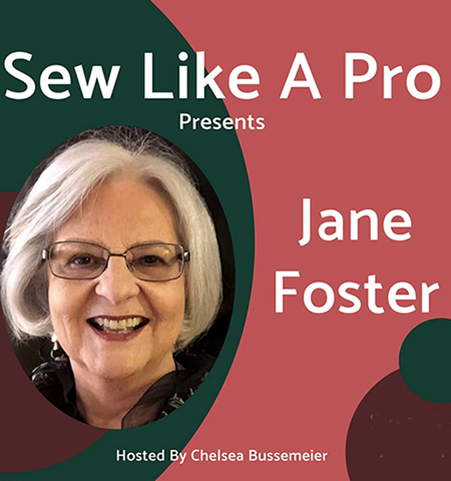
Jane Foster was interviewed about interfacing on Sew Like a Pro.

Jane Foster was interviewed about interfacing on Sew Like a Pro.
When most beginning sewers first buy interfacing, they are intimidated by the vast array of neutral bolts that are either “hidden” under or behind the counters! After all, interfacing is certainly not colorful, or a pleasure to feel and touch compared to the beautiful yardage surrounding it in the store. It is controlled and formal in its black, white, and grey and seems to say, “I’m here on the shelf and you should know what you want”. Considering that the use of the appropriate interfacing and correct pressing techniques can change a “loving hands at home look” into a professional custom garment, I am all for sharing the mystiques of interfacing and spreading the word.
Interfacing comes in the form of fabric. It is not very colorful and on first glance the bolts all look the same. It can be bought by the yard or in packets. It comes in either narrow about 20” or wider about 60” width.
Interfacing gives certain parts of garments support and stability and keeps them looking newer for longer. It gives strength where it would otherwise be weak after washing.
Interfacing although not seen in the finished garment, is put in collars, collar stands, cuffs, and behind buttonholes and buttons. It is often put in hems, and nearly always in facings, pockets and pocket flaps. Interfacing is at the back of welt pockets or along a bias cut edge to stop stretching.
Consider grain before cutting out interfacing pieces. Does it need to be on grain with the fabric or maybe bias if it’s going around a curved hem.
In order to choose which interfacing to use, one needs to audition interfacing to fabric to find the perfect match. This involves making small 4”x4” samples of sew in and fusible interfacing.
There are three distinct areas of choice with interfacing.
1. The weight from featherweight through to heavyweight canvas.
2. The fabric structure of the interfacing, such as woven or knitted, non-woven or weft insertion. (a combination of woven and knitted)
3. How it is applied either fusible or sew-in.
Before choosing to interface one needs to consider the fashion fabric and the style of the garment being created. Does the collar need to be crisp or soft? Does the knit fabric need extra stability where the buttonholes are? It is sometimes necessary to use more than one type of interfacing in one garment. Generally, avoid interfacings that are heavier than the fashion fabric when making everyday garments.
This is an debatable question. There is very little shrinkage in non woven sew ins and fusible interfacings, but woven interfacings and weft insertions do shrink as they often have cotton and rayon in them. To be safe, wash your sew in interfacing the same way as you pre wash your fabric. The fusible interfacings need the “dip and drip” method for pre shrinking. Fold up the yardage and put into hand hot water for about 10 minutes. Carefully towel out excess moisture and hang to air dry before cutting out. For heavier weight interfacing such as canvas that cannot be washed, then pre shrink by steaming with the iron.
Light and medium weight Sew- in interfacing is cut to the same size as the part to be supported, and then basted in place. As the garment is constructed it gets included in the seam allowances and lives inside the garment anchored in place.
Fusible interfacing becomes one with the fabric after the glue is melted. Place the fabric pattern piece right side down on the ironing board. Place the interfacing which has been trimmed 1/8” smaller, glue side down on top of fashion fabric. Lay a cloth of cotton, linen or silk carefully over the top. Lightly spritz the cloth with water and use a press, hold for 15 seconds and lift action with the iron over the whole piece. Remove the press cloth, check on the fuse and set the piece aside to cool.
Pellon is a big supplier of interfacing in the US. Look at Pellonprojects.com and you will find an extensive list of the different types of interfacing that Pellon sells plus their weight and uses. Vilene is the interfacing in the UK. When interfacing is purchased in large fabric stores, the instructions and tips are included for application on a plastic insert inside the bolt.
I advise students to buy a selection of different interfacings and build up a supply. Then, when it comes to making your choices, you can make samples and feel and compare and make educated decisions. Fusible interfacing, as is, becomes an entirely different animal after the glue has melted with heat and moisture and it becomes one with your fashion fabric. Therefore, samples are a must!
I like to buy the wider 60’ interfacing and I suggest you buy a selection including:
.
Happy Sewing and make samples first. Jane Foster